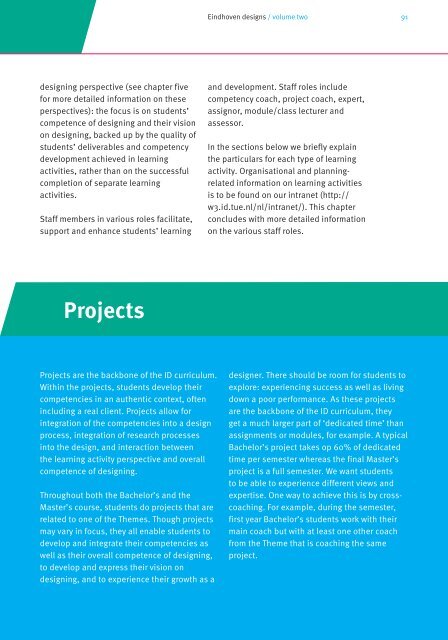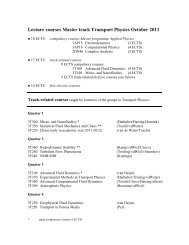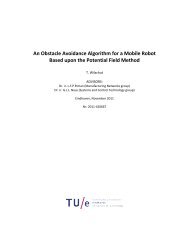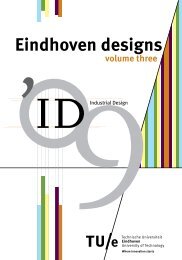Education guide 'Eindhoven designs' - Technische Universiteit ...
Education guide 'Eindhoven designs' - Technische Universiteit ...
Education guide 'Eindhoven designs' - Technische Universiteit ...
You also want an ePaper? Increase the reach of your titles
YUMPU automatically turns print PDFs into web optimized ePapers that Google loves.
Eindhoven designs / volume two 91<br />
designing perspective (see chapter five<br />
for more detailed information on these<br />
perspectives): the focus is on students’<br />
competence of designing and their vision<br />
on designing, backed up by the quality of<br />
students’ deliverables and competency<br />
development achieved in learning<br />
activities, rather than on the successful<br />
completion of separate learning<br />
activities.<br />
Staff members in various roles facilitate,<br />
support and enhance students’ learning<br />
and development. Staff roles include<br />
competency coach, project coach, expert,<br />
assignor, module/class lecturer and<br />
assessor.<br />
In the sections below we briefly explain<br />
the particulars for each type of learning<br />
activity. Organisational and planningrelated<br />
information on learning activities<br />
is to be found on our intranet (http://<br />
w3.id.tue.nl/nl/intranet/). This chapter<br />
concludes with more detailed information<br />
on the various staff roles.<br />
Projects<br />
Projects are the backbone of the ID curriculum.<br />
Within the projects, students develop their<br />
competencies in an authentic context, often<br />
including a real client. Projects allow for<br />
integration of the competencies into a design<br />
process, integration of research processes<br />
into the design, and interaction between<br />
the learning activity perspective and overall<br />
competence of designing.<br />
Throughout both the Bachelor’s and the<br />
Master’s course, students do projects that are<br />
related to one of the Themes. Though projects<br />
may vary in focus, they all enable students to<br />
develop and integrate their competencies as<br />
well as their overall competence of designing,<br />
to develop and express their vision on<br />
designing, and to experience their growth as a<br />
designer. There should be room for students to<br />
explore: experiencing success as well as living<br />
down a poor performance. As these projects<br />
are the backbone of the ID curriculum, they<br />
get a much larger part of ‘dedicated time’ than<br />
assignments or modules, for example. A typical<br />
Bachelor’s project takes op 60% of dedicated<br />
time per semester whereas the final Master’s<br />
project is a full semester. We want students<br />
to be able to experience different views and<br />
expertise. One way to achieve this is by crosscoaching.<br />
For example, during the semester,<br />
first year Bachelor’s students work with their<br />
main coach but with at least one other coach<br />
from the Theme that is coaching the same<br />
project.

















